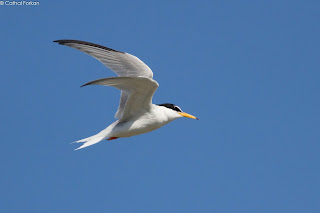22 days since our first egg was discovered and the first few clutches are starting to hatch here at Kilcoole. This morning while doing nest checks I found our first Little Tern chick, small, frail and still wet from the egg, but ready to take on the world! The team this year have decided to name this wee ternlet 'Laurence' after the excellent and enthusiastic classes we had visit from St Laurence's NS in Greystones. It's amazing looking at this tiny hatchling and imagining the monstrous migration that it will begin in only a matter of weeks... For now though, it's content under the warm wing of an incubating parent. This first chick was actually in the southern 'satellite' colony. We've got cracks appearing in a further 15 or so eggs, so this first chick won't be alone for long.
So far things are looking good for the terns. We're on over 140 active nests, and suspect this number might grow slightly. Although marginally below last years total this is still excellent going and we're hopeful for the coming weeks.
Weather is now our single biggest concern. The flattened profile of the beach(due to winter storms) means water can travel quite far up the beach with even a moderately high tide and some onshore breezes. This is exacerbated by the fact that we're nearing spring tides. Today we had to contend with a boisterous sea sloshing over the high water mark. Unfortunately four tern pairs had scrapes below said high-water line, and so a decision was made to lift their eggs from the nests and incubate them artificially. When the tide receded the eggs were quickly replaced, and the parent birds settled back down on the eggs as if nothing had happened! By doing this we managed to save three nests from certain destruction, a fourth was lost to the sea.
In other news our first nest of Oystercatcher has finally hatched. As a result the parent oystercatchers can be seen viciously dive-bombing the wardens when we enter the colony to complete nest checks. Their ferocity is understandable when you see the three balls-of-fluff they are safe-guarding. The parents can be seen tenderly feeding the young small pieces of dead crab/worms. I'm expecting they'll soon bring the chicks across the beach and train tracks into the lagoon behind, where the feeding is better.
In bird news the Garganey has been re-sighted on and off from the colony. We've had a few Mediterranean Gull fly past the colony, and we were delighted to have a Roseate Tern for a day. This tern was probably a non-breeder, and by rights should be up at Rockabill around now.
Thanks for reading, and don't forget to pop down to visit the colony. We're a short 20 minute walk south of Kilcoole train station. The next few weeks would be an excellent time to visit as chicks will be hatching and visible. Friendly wardens are always on site to show visitors the terns and other beach inhabitants!
Cathal and the Kilcoole Team
'Laurence' the ternlet- left at first hatching, right after drying out a bit
The last two ringed plover nests to hatch
 |
| Oystercatcher chick- 'I'm a rock and you can't see me' |
 |
| Male Little Tern with a fish for his incubating partner |
 |
 |
| Roseate Tern- Ireland's second rarest breeding tern |
 |
| Skylark |
 |
| One of two broods of cygnets locally |









